Blood Secrets: Chronicles of a Crime Scene Reconstructionist Read online
Page 17
But there were no bullet holes in the Stealth’s door. Whoever shot Bakley fired through the open car window. That meant she saw her killer pointing a gun at her and leaned to her left toward the driver’s side in a classic defensive posture. She didn’t have enough time to do anything else to protect herself. In my opinion, the first bullet struck her in the head and the second hit her shoulder, though I couldn’t be certain. Expirated blood covering the gearshift showed that she slumped farther to her left after she was hit and exhaled blood onto it in her last few minutes of life.
To help the jury understand all this, I filmed an actress sitting in a car reenacting Bakley’s movements in response to what I judged was the order of the shots. Then I worked with animation specialists to create a computerized video reconstruction of the crime, which we played during the trial.
Of course, none of this implicated or exonerated Blake. It simply helped jurors comprehend exactly what happened during Bakley’s murder.
The tensest moment for me came not on the witness stand, but after I testified and the trial broke for lunch. The courtroom was on the eighth floor, so I ducked into an empty elevator and pressed the button for the ground level, intending to grab a quick sandwich. The doors were just closing when someone thrust an arm between them. They slammed on it, then reopened. There stood Robert Blake. We gazed at each other for a second, then he stepped in, the doors closing behind him. Both of us stood there in stone-faced silence, staring intently at the ceiling, the elevator buttons, the floor, anywhere but at each other. It was the longest elevator ride of my life.
Not surprisingly, Blake’s case proved a gold mine for tabloids and gossip magazines. The irascible actor went through a revolving door of high-profile defense lawyers, partly because of his insistence on granting jail house interviews to famous-name reporters Barbara Walters and Diane Sawyer. When his counsel changed, it sent jury selection back to square one. Then during the trial itself, two colorful former stunt-men from Blake’s Baretta days, a private investigator, and a hood-turned-minister all stepped forward to say that Blake had offered them money to “whack” or “snuff” Bakley.
On March 16, 2005, Blake was finally acquitted of murdering his wife, though the jury remained deadlocked eleven to one on the solicitation of murder count until the judge dismissed the charge. Blake’s longtime bodyguard, Earle Caldwell, was also acquitted.
When he finally walked out of criminal court a free man, Blake was seventy-one. The following year, Bakley’s relatives brought a wrongful death suit against him in civil court. I was again asked to provide an analysis of how the crime unfolded based on blood spatter and bullet wounds, though I didn’t have to testify. Blake lost the case and was ordered to pay his late wife’s relatives $30 million. He declared bankruptcy less than three months later.
Straightforward Evidence: The Cases of Ennis Cosby and Selena Quintanilla-Pérez
Blood doesn’t always tell a story. Sometimes it does no more than confirm what is already obvious to police at a crime scene. I’ve been asked to examine evidence in several high-profile murders to see whether critical clues might lie hidden in the blood spatter but found nothing that would change the direction of an investigation or trial. That was true in the tragic deaths of both Ennis Cosby and Tejano singer Selena Quintanilla-Pérez.
Twenty-seven-year-old Ennis Cosby, son of comedian Bill Cosby, was shot to death on a service road off the 405 Freeway in Southern California as he tried to change a flat tire on his Mercedes around one A.M. on January 16, 1997. Cosby was en route to his friend Stephanie Crane’s home when the tire blew and he called her for help. She drove to meet him and used her car’s lights to illuminate the roadside, making the tire change easier. While she waited, a man suddenly appeared at her door and in a heavy accent ordered, “Get out of the car or I’ll kill you.” Instead, she hit the gas. Seconds later, she spun her car around and, to her horror, saw her friend lying in a pool of blood as the man sprinted away.
I was lecturing for the Los Angeles District Attorney’s Office when it happened, and LAPD homicide detective Vic Pietrantoni asked me to inspect Cosby’s bloody clothing as well as images from the crime scene and tell him whether any signs in the blood pointed to a setup involving Stephanie Crane. Did the victim’s split lip suggest a scuffle before the shooting? Did the fact that the shooter stood next to Crane’s driver’s-side window or the fact that she drove off while Cosby was being shot suggest that she had helped to set him up? Was this a possible dispute between people who knew each other and had arranged to meet off 405 in the middle of the night? Did the fact that Cosby’s body had been turned onto his back mean anything?
But the blood patterns bore out exactly what was reported and what the murderer himself later confirmed. An eighteen-year-old opportunist thug from the Ukraine spotted a young African-American man with an expensive car, decided to rob him, and just as casually shot him in the head because he took too long to hand over his wallet, never knowing he was the son of one of America’s best-loved actors. Stephanie Crane had no involvement in the crime. The assailant flipped his victim over to pick his pocket, then kicked him in the mouth as a final insult before fleeing. After bragging about the killing to co-workers, Mikhail Markhasev was arrested, tried, and sentenced to life in prison plus ten years. He later apologized to the Cosby family. In one of those odd small-world twists, Detective Vic Pietrantoni’s wife, Deputy District Attorney Anne Ingalls, led the prosecution team.
Had there been more to the murder, we would likely have seen evidence of a conspiracy such as additional tire tracks, footprints from co-conspirators’ shoes, signs that a struggle took place, or wounds from more than one weapon.
The blood patterns were equally straightforward in the murder of Selena Quintanilla-Pérez, shot to death by her fan club president, Yolanda Saldívar, on March 31, 1995. When the twenty-three-year-old singer discovered that her supposed number one fan was embezzling money from a chain of boutiques the Quintanilla family ran, she fired her. The two met at a Days Inn in Corpus Christi, Texas, ostensibly so Saldívar could hand over some business documents, but as Quintanilla-Pérez was leaving the hotel room, Saldívar shot her in the back. The injured star stumbled to the front desk and told the staff what had happened before collapsing. She died from loss of blood at a nearby hospital a few hours later.
The defense for Saldívar wanted to know if I could find anything unusual in the blood spatter that might mitigate the circumstances or suggest self-defense, but the scene was a simple one to analyze from the crime scene photos. As you know, we work backward in crime scene reconstruction, from point Z to point A. Here, a trail of blood terminated abruptly in front of the hotel desk. The droplets, with their characteristic directional spines, showed that the victim had staggered to the lobby from the hallway. Her path led back to the interior of a guest room doorway, where high-velocity blood spatter on the carpet, walls, door frame, and door showed that the initial injury was a gunshot wound and that—calculating the dead woman’s height and the height of the bloodstains—the bullet entered the victim’s body in the middle of her back. There was no indication of a struggle, no hint in the blood of any other activity that might have altered my reading of what happened. The police interpretation of events was on the mark from what I could see. I told the defense there was nothing I could add. Saldívar was found guilty of the murder.
In many other homicides, though, blood tells a riveting story. There is no better example than what most Americans call “the O. J. Simpson Case.”
Case Study: O. J. Simpson and the River of Blood Evidence
When Nicole Brown Simpson’s white Akita wouldn’t stop barking late on the evening of June 12, 1994, neighbors in L.A.’s wealthy Brentwood enclave went to see if anything was wrong. They found the dog wandering Bundy Drive in front of Brown’s1 condo around eleven P.M. The Akita was almost frantic—whining, barking, and pacing incessantly. Thinking it might be injured, one man bent down to take a closer look and saw that the
animal’s fur and paws were caked with something red. Alarmed, another neighbor peeked over the fence that sheltered Brown’s condo from the street.
1 In subsequent references to Nicole Brown Simpson, she is referred to as “Brown” rather than “Brown Simpson” for clarity. In subsequent references to O. J. Simpson, he is referred to as “Simpson.”
That’s when they saw the blood. Someone had smeared it all over the walkway. Great rivulets of red had run all the way to the front gate from the condo’s steps.
Police responding to their 911 call just after midnight spotted the source of all the blood immediately. The body of Nicole Brown Simpson, thirty-five-year-old ex-wife of former pro football star O. J. Simpson and mother of two of his children, was slumped at the bottom of the steps outside her home. Brown had been stabbed multiple times, and her throat had been slashed so deeply that her head had almost been severed from her neck. Her face was swollen as though someone had beaten her, and—as coroners would note in the autopsy—so much of her blood had run down the garden path that there was almost none left in her body.
Lying near her was the body of a man who would soon be identified as Ronald Goldman. The twenty-five-year-old aspiring actor and model waited tables at a nearby restaurant called Mezzaluna Trattoria and had become friendly with Brown, a frequent customer who worked out at the same gym he did. As investigators learned, Brown had dined at Mezzaluna that evening with her parents and children, and when Brown’s mother called the restaurant to say she had accidentally left her glasses there, Goldman volunteered to drop them off after his shift. Like Brown’s, Goldman’s throat had been slashed. He had also been stabbed repeatedly in the torso and thigh. All in all, he had suffered nineteen stab wounds. Autopsies would reveal that the murder weapon was a blade at least six inches long.
Brown’s eight-year-old daughter and five-year-old son were still asleep on the second floor and had to be awakened by police. They had slept through the carnage below, mercifully unaware.
As far as blood evidence goes, the crime scene was a bonanza. A trail of bloody footprints next to a line of blood droplets led from both victims to the back of the property. Several objects lay near Goldman’s body, including a bloodstained brown leather glove and a blood-spattered white envelope containing a pair of women’s glasses.
Within hours, police on the scene received orders from their commander to drive to the home of O. J. Simpson a few miles away on Rockingham Avenue. They were to tell him his ex-wife was dead and ask him to take charge of the children. Among the four homicide detectives who went to Rockingham were Tom Lange and Philip Vannatter, both from the LAPD Robbery/Homicide Division’s elite Homicide Special Section, which handles high-profile murder cases and which had officially taken over the investigation, with Lange and Vannatter assigned as the lead detectives. Accompanying them were detective supervisor Ron Phillips and detective Mark Fuhrman, both of the LAPD’s West Los Angeles Division. Fuhrman had gone to Simpson’s home years earlier as a patrol officer in response to a distress call from Brown—one of many she made when her husband’s temper exploded into threats and violence.
When the detectives pulled up to Simpson’s walled estate, they saw a white Ford Bronco parked with its wheels on the curb, its back end in the street. While waiting for someone to answer the door, they ran a license check on the vehicle and learned it was leased to Simpson by Hertz. As Fuhrman was shining his flashlight on it, he noticed a reddish smear on the outside of the door. It looked as if it might be blood.
What if the ex-football star, too, were dead or dying inside his mansion? No one answered their repeated knocks and phone calls, so the four concurred and judged the circumstances urgent. That permitted them to enter the property without a search warrant. Fuhrman scaled the wall and unlocked the gate for his colleagues. Again they tried to awaken whoever was inside the main house but got no answer. Next they tried a trio of bungalows on the property. Two of the doors opened. Arnelle Simpson, the ex–NFL star’s daughter from his first marriage, peered out bleary-eyed from one bungalow. In the other doorway stood Brian Kato Kaelin, an aspiring actor pal of Simpson’s who was a quasi-permanent house guest at Simpson’s estate.
Kaelin told police that he had eaten dinner with Simpson at McDonald’s the night before, then spent the evening in his bungalow. He was on the phone with his girlfriend when he heard three wall-rattling bangs and went outside to find the source of the commotion. He saw a limo near the front gate and, remembering that his host was planning to catch the red-eye to Chicago, hurried over to help him load his bags.
While Kaelin talked, Arnelle Simpson found a phone number for her father’s hotel in Chicago, and Ron Phillips placed the call. Simpson answered. He sounded horrified at the news of his ex-wife’s death and promised to catch the next flight home. He didn’t ask how she had died, though, which struck Phillips as odd. It’s almost always the first question people ask.
While Phillips was calling Simpson, the other detectives investigated the estate’s grounds. Fuhrman trained his flashlight over the area where Kaelin said the loud bumps had originated, and the beam fell on a brown leather glove. It looked just like the one at Bundy Drive, and like that one, it appeared to be stained with blood. He hurried back to the house to get Phillips. About the same time, Vannatter spotted what looked like blood drops in the driveway. He followed them to the Bronco and, shining his flashlight onto the car, spied again the suspicious smear Fuhrman had noticed on the driver’s door latch as well as what appeared to be more stains inside the vehicle. The trail led on to the front door of the main house. The detectives left the evidence where they found it, vacated the premises, secured it, and obtained a search warrant to re-enter. The glove and other items would be photographed and collected by criminalists from the lab.
When Simpson returned from Chicago, homicide detectives took him to the Parker Center for questioning and fingerprinting. He wasn’t under arrest or charged with any crime. He went voluntarily and answered questions. The officers questioning him noticed a bandage on the middle finger of his left hand and asked if they could photograph the wound. Simpson said okay. He also let a male nurse draw blood for DNA tests. He didn’t seem particularly worried, though he contradicted his version of events from the night before several times.
But after lab results showed that the glove found at Rockingham was soaked with both Brown’s and Goldman’s blood, the Los Angeles District Attorney’s Office issued a warrant for Simpson’s arrest on June 17. Police went to lawyer Robert Kardashian’s home to pick him up. It turned out they were too late. Simpson and his friend Al Cowlings had driven off in Cowlings’s white Ford Bronco, also leased from Hertz. (O.J.’s bloodstained white Ford Bronco had already been seized and submitted into evidence.) What followed was a surreal televised slow-speed chase with news helicopters and bystanders shouting from overpasses. The procession eventually led back to Rockingham, where Simpson surrendered and police searching the Bronco found a loaded gun, a passport, and a fake beard and mustache. Simpson was arraigned a few days later but pleaded not guilty to murder charges.
In the months that followed, while “the Juice” cooled his heels in a private cell, an all-star cast of defense lawyers lined up to defend him, including the now familiar names of Robert Shapiro, F. Lee Bailey, Johnnie Cochran, and DNA trial specialists Barry Scheck and Peter Neufeld. The media dubbed them the Dream Team.
At the outset, the case appeared almost airtight. Simpson seemed to have done everything but leave his calling card at the murder scene. Lab tests showed that hairs on Goldman’s shirt and inside a navy knit cap found lying on the ground near his blood-covered body belonged to Simpson. So did blood droplets nearby. A pair of socks retrieved from the foot of Simpson’s bed tested positive for Brown’s blood, and its fibers matched fibers found on Goldman’s clothing. Tests of the bloodstains inside the Bronco revealed DNA from all three people—the murder victims and Simpson himself.
Add to that testimony from witnesses li
ke limo driver Allan Park, who said he rang the doorbell at the front gate on Rockingham for twenty minutes, then caught sight of a tall African-American man in dark clothes sprinting toward the estate’s side door just before eleven P.M. Simpson answered the intercom moments later, claimed he had overslept, and hurried down to load his bags, drenched in sweat.
Of course, the case turned out to be anything but a slam dunk for prosecutors, who were hardly braced for what the Dream Team had in store. Simpson’s defense lawyers launched a furious attack on the credibility of the witnesses, the evidence, and the cops who spotted it. They made mincemeat of criminalist Dennis Fung and his assistant Andrea Mazzola, suggesting the pair had so botched the evidence handling and used such shoddy collection techniques that the blood samples had been irreparably contaminated. Blood samples from Bundy Drive had been stored in plastic bags temporarily, hadn’t they? Couldn’t plastic bags cultivate bacteria? Wouldn’t that destroy test result accuracy?
That was just the beginning. Why had the male nurse at the Parker Center recorded drawing eight milliliters of blood from Simpson when six and a half were in the vial? The nurse said he had estimated the amount, but couldn’t someone have filched the “missing” blood to plant evidence around Bundy and Rockingham?
The someone they had in mind was Mark Fuhrman. Why Fuhrman? Fuhrman despised African-Americans, the defense said. For proof, they produced ten-year-old taped interviews made by aspiring screenplay writer Laura Hart McKinney of the homicide detective spouting a slew of racial slurs and lurid descriptions of violent acts against African-American suspects taken in the line of duty. Fuhrman claimed he was acting—creating an exaggerated character of a bigoted cop—but the damage was done. Johnnie Cochran likened him to Adolf Hitler, a genocidal maniac who would stop at nothing to destroy a black man.

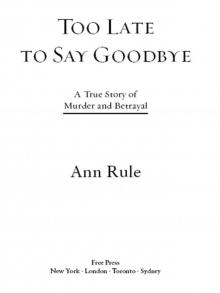 Too Late to Say Goodbye: A True Story of Murder and Betrayal
Too Late to Say Goodbye: A True Story of Murder and Betrayal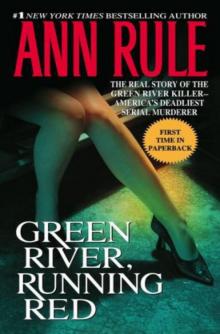 Green River, Running Red
Green River, Running Red Bitter Harvest
Bitter Harvest Dead by Sunset: Perfect Husband, Perfect Killer?
Dead by Sunset: Perfect Husband, Perfect Killer?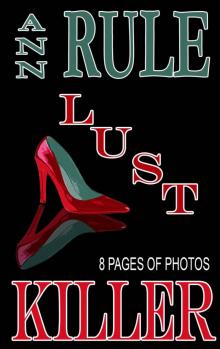 Lust Killer
Lust Killer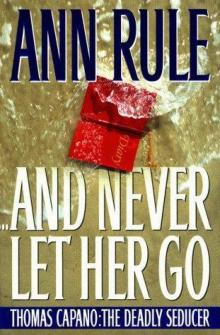 And Never Let Her Go: Thomas Capano: The Deadly Seducer
And Never Let Her Go: Thomas Capano: The Deadly Seducer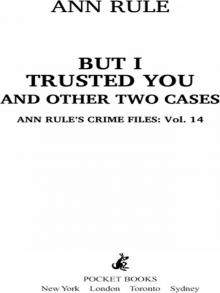 But I Trusted You and Other True Cases
But I Trusted You and Other True Cases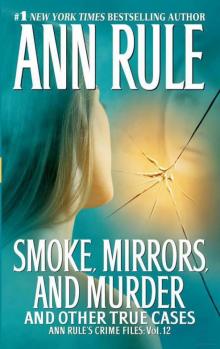 Smoke, Mirrors, and Murder and Other True Cases
Smoke, Mirrors, and Murder and Other True Cases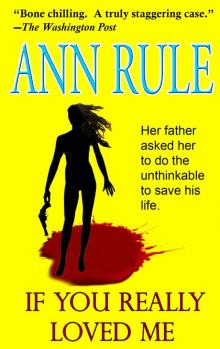 If You Really Loved Me
If You Really Loved Me Kiss Me, Kill Me and Other True Cases
Kiss Me, Kill Me and Other True Cases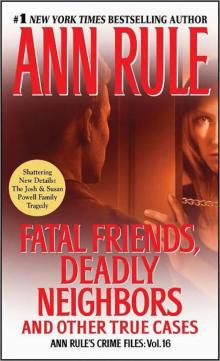 Fatal Friends, Deadly Neighbors and Other True Cases
Fatal Friends, Deadly Neighbors and Other True Cases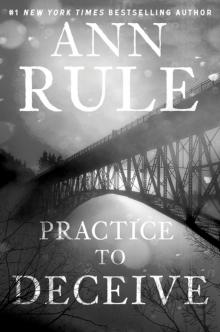 Practice to Deceive
Practice to Deceive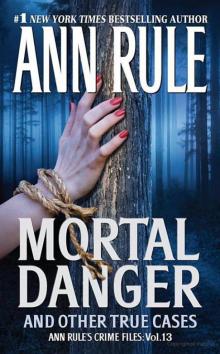 Mortal Danger and Other True Cases
Mortal Danger and Other True Cases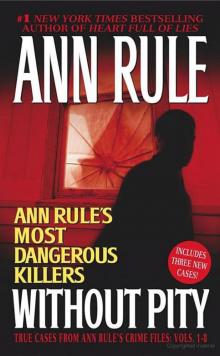 Without Pity: Ann Rule's Most Dangerous Killers
Without Pity: Ann Rule's Most Dangerous Killers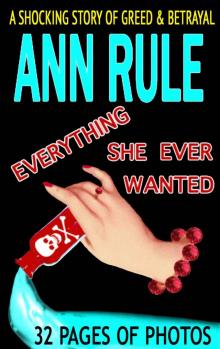 Everything She Ever Wanted
Everything She Ever Wanted A Fever in the Heart and Other True Cases
A Fever in the Heart and Other True Cases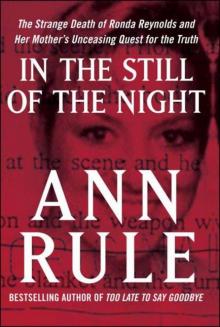 In the Still of the Night
In the Still of the Night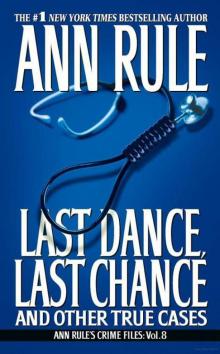 LAST DANCE, LAST CHANCE - and Other True Cases
LAST DANCE, LAST CHANCE - and Other True Cases A Rage to Kill
A Rage to Kill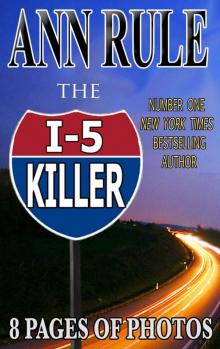 The I-5 Killer
The I-5 Killer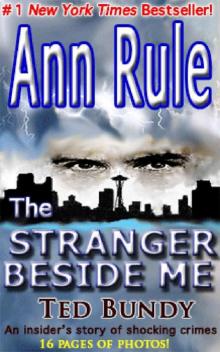 The Stranger Beside Me
The Stranger Beside Me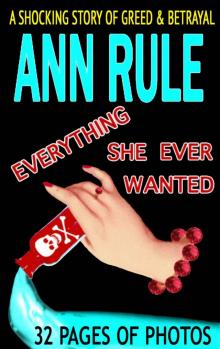 Everything She Ever Wanted: A True Story of Obsessive Love, Murder, and Betrayal
Everything She Ever Wanted: A True Story of Obsessive Love, Murder, and Betrayal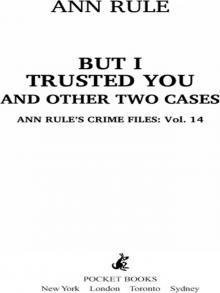 But I Trusted You
But I Trusted You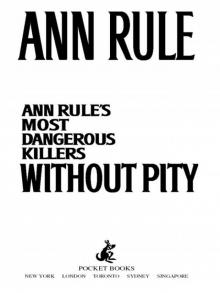 Without Pity
Without Pity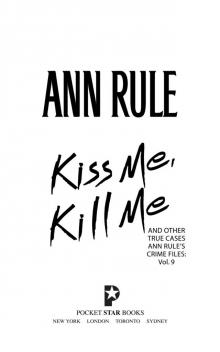 Kiss Me, Kill Me
Kiss Me, Kill Me Too Late to Say Goodbye
Too Late to Say Goodbye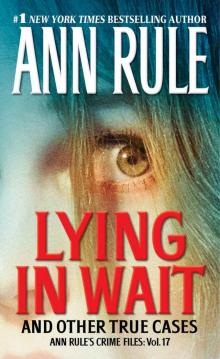 Lying in Wait
Lying in Wait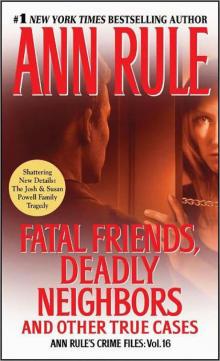 Fatal Friends, Deadly Neighbors
Fatal Friends, Deadly Neighbors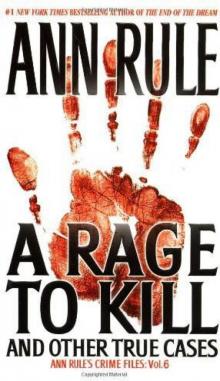 A Rage to Kill: And Other True Cases
A Rage to Kill: And Other True Cases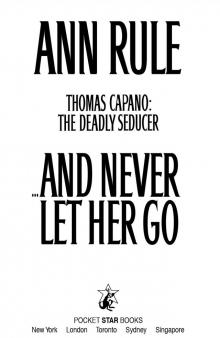 And Never Let Her Go
And Never Let Her Go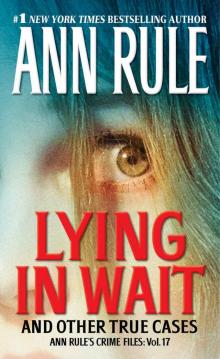 Lying in Wait Ann Rule's Crime Files Vol.17
Lying in Wait Ann Rule's Crime Files Vol.17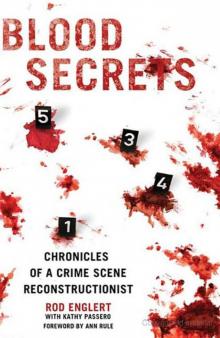 Blood Secrets: Chronicles of a Crime Scene Reconstructionist
Blood Secrets: Chronicles of a Crime Scene Reconstructionist No Regrets
No Regrets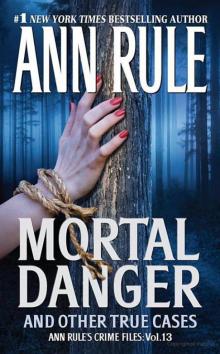 Mortal Danger
Mortal Danger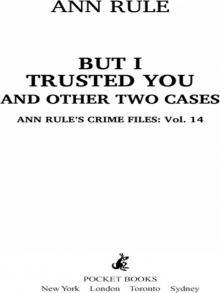 But I Trusted You: Ann Rule's Crime Files #14
But I Trusted You: Ann Rule's Crime Files #14 Empty Promises
Empty Promises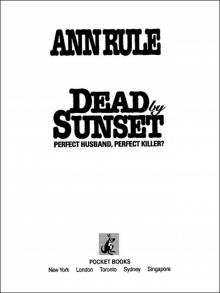 Dead by Sunset
Dead by Sunset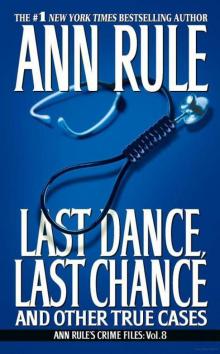 Last Dance, Last Chance
Last Dance, Last Chance Don't Look Behind You
Don't Look Behind You